This paper wants to examine the sources of language anxiety, how it can affect the learning process of learners, and which consequences probably arise.
Firstly, some definitions of the concept of anxiety will be discussed, determining the different types of anxiety, and including the several forms of foreign language anxiety (FLA). Secondly, the historical development, in addition to the approaches and theories used shall be explained, before the many factors that can cause language anxiety will be presented. Having dealt with the causes of it, the currently used assessment process will be discussed briefly. After that, different techniques and methods that language teachers and instructors can use to support learners with language anxiety are presented. Finally, the current trends in the research of FLA, as well as some outlooks will be given.
Inhaltsverzeichnis (Table of Contents)
- Introduction
- Definition(s) of anxiety
- Types of anxiety
- Types of (F)LA
- Development and theories about language anxiety
- Approaches
- Theories
- Causes and factors of foreign language anxiety
- Assessment of FLA
- Reducing language anxiety
- Current trends in the research of FLA
- Conclusion
Zielsetzung und Themenschwerpunkte (Objectives and Key Themes)
This seminar paper aims to provide an overview of the topic of anxiety in English as a second language. It explores the sources of language anxiety, its impact on the learning process, and the potential consequences. The paper will examine the historical development and theories related to language anxiety, analyze the factors that contribute to it, and discuss assessment methods. The paper will also explore techniques to reduce language anxiety and review current research trends in the field.
- Definitions and types of anxiety, including foreign language anxiety (FLA)
- Historical development, approaches, and theories related to language anxiety
- Causes and factors that contribute to foreign language anxiety
- Assessment of FLA and methods for reducing language anxiety
- Current trends and future directions in the research of FLA
Zusammenfassung der Kapitel (Chapter Summaries)
- Introduction: This chapter introduces the topic of language anxiety as a significant affective factor hindering students' learning process. It outlines the paper's objectives and research questions, focusing on exploring the sources of language anxiety, its impact on learning, and potential consequences.
- Definition(s) of anxiety: This chapter defines anxiety as a subjective feeling of tension and apprehension associated with autonomic nervous system arousal. It explores different types of anxiety, including general trait and state anxiety, highlighting the need for distinguishing between general anxiety and anxiety specific to language learning. It also introduces the concept of foreign language anxiety (FLA) as a situation-specific type of anxiety, similar to test anxiety or stage fright.
- Types of anxiety: This chapter delves into the distinction between trait and state anxiety, highlighting their relevance to second language acquisition (SLA) research. It also mentions the role of general anxiety and communicative anxiety in foreign language learning, where trait anxiety reflects stable personality traits, while state anxiety arises from anxiety-provoking stimuli. Situation-specific anxiety is introduced as a broader concept encompassing various facets of anxiety.
- Types of (F)LA: This chapter focuses specifically on foreign language anxiety (FLA), highlighting its complex nature and the various types and definitions that have emerged over time. The influential definition of FLA coined by Horwitz et al. (1986) is presented, emphasizing its relationship to self-perceptions, beliefs, feelings, and behaviors in the language learning context. FLA is also discussed as a multifaceted concept influenced by internal physiological processes, cognitive and emotional states, situational demands, and social interactions.
Schlüsselwörter (Keywords)
The primary keywords and focus topics of this seminar paper are: foreign language anxiety (FLA), language anxiety, second language acquisition (SLA), trait anxiety, state anxiety, situational anxiety, communicative anxiety, assessment of FLA, reducing language anxiety, current trends in FLA research.
- Quote paper
- Christina Binter (Author), 2021, Anxiety in learning English as a second language, Munich, GRIN Verlag, https://www.hausarbeiten.de/document/1247279


